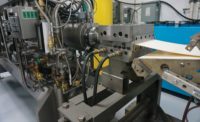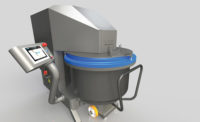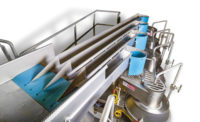The label is the face of a brand. It helps if a product stands out on a crowded shelf, clearly displaying its contents.
A label also must provide shoppers with practical information about the product itself including details related to contents and the use-by date, both especially important in the bakery and snack industries.
Bakers and snack producers must, therefore, consider many factors when choosing labeling equipment and materials.
Clear communication
“Consumers are increasingly looking for nutritious snacks they can grab and go,” says John J. Gorack, sales manager, WS Packaging Group Inc., Green Bay, WI. “For products in clear poly wrap, the labeling needs to help deliver on the brand promise of freshness and on the product positioning.”
Transparency also applies to messaging, Gorack adds. Providing consumers with essential information about the product helps build relationships with them.
Kwik Lok Corp., Yakima, WA, offers pre-printed closure labels that provide much of the information bakers and snack producers need to convey, according to Rich Zaremba, national sales manager for the company. “This could be variable, promotional or brand information,” he explains. “Our closure labels not only close the bag, but offer a consistent area where information can be found.”
It also helps to make things easy for retailers, notes Chirag Sheth, vertical marketing manager, Videojet, Wood Dale, IL. “Increasingly, bakers and snack producers are being asked by retailers to place their products in shelf-ready packaging, he says. “The color scheme and design of shelf-ready packaging is heavily influenced by retailers, so food processors need flexibility in labeling on a variety of packaging types and substrates.
“In addition, the ‘scanability’ of barcodes placed on cases is critical to manufacturers, because retailers use automated systems within their distribution centers for inventory management,” continues Sheth. “Bakers and snack producers need to understand which equipment will provide the best quality barcodes, based on packaging type and substrate.”
Government regulations and food-safety concerns also demand that the quality and specifics of printed labels be high-quality. “In the past, coding was simply a matter of listing price information and data, and possibly some codes more specific to what the facility wished to track,” Zaremba says. “Now, real date, time and traceability information is on everyone’s minds. It is important that customers can read this information so that they can act on any recalls or safety-related concerns or issues.”
According to Zaremba, the need for a medium to communicate variable information is requested by food processors now more than ever. “Whether it is printing directly on our closure or closure label, the need to print in a legible, consistent area is one of the main concerns of bakers and snack producers,” he says.
Label lessons
A product label may be eye-catching, easy-to-read and filled with pertinent information, but if it doesn’t adhere to the product packaging, it’s ineffective. “At the end of the day, the label has to stay with the product it cannot fall off,” Gorack says. “So you have to think about what a product might be exposed to once the consumer takes it home. Whether it’s kept at room temperature in a kitchen cabinet, in the refrigerator or freezer, or exposed to humid conditions, the label has to perform. We take all these environments into account when determining the best combination of label material, ink and adhesive.”
WS Packaging Group recently expanded its pressure-sensitive labeling line with the addition of the Ravenwood linerless labeling system, which is designed to improve the labeling of trays, clamshells and skin packs for baked goods, ready-to-eat meals, frozen pizza and multipacks. The face of the label stock has a silicone release coating that prevents labels on a roll from sticking to those wound underneath. Promotional information, coupons and recipes can be printed, as well.
John O’Donnell, sales manager, EPI Labelers, New Freedom, PA, acknowledges that one of the top challenges for bakers and snack producers is using label adhesives that are compatible with their packaging materials to ensure long-term adhesion. The company manufactures a bakery labeler that applies labels to packages ranging from flexible bread and bun bags to rigid cake and pie containers. The unit features a pivoting applicator assembly that allows quick changeover from the top to the side of the package application without moving the labeler.
Many companies purchase their labels before they have all the facts, notes Katie Williar, marketing coordinator, EPI Labelers, adding that bakers and snack producers should consider the following factors before making a purchasing decision:
- Need
- The item being labeled
- What the item is made of
- The application surface and condition (plastic, smooth, clean, rigid)
- The label location
- Where on the production line the labeling process will take place
- The product’s storage environment (indoors, outdoors, room temperature, freezer)
- Packaging volume and graphics requirements
“Based on the product and the labeler, you can then go to your label manufacturer,” Williar says. “Keep in mind that there are many kinds of labeling adhesives. Share as much information with your supplier as you can to ensure you are getting the best label for the job.”
Printer pointers
Just like there are numerous label options for bakers and snack producers to choose from, there are many printers capable of turning those labels into miniature works of art.
Primera Technology Inc., Plymouth, MN, manufactures desktop label printers that allow users to print on the label material, not directly on the product itself. These printers provide flexibility for small to midsized companies that want to print short-run labels on demand. By bringing their label production in-house, snack producers and bakers can print only the quantity of labels needed, which cuts down on inventory and wasted labels, says Amber Miller, product manager for the company.
Primera recently introduced the LX2000 desktop color label printer, which produces labels at speeds up to 6 inches per second. Typical applications include product labels for bakery, confectionary and a wide range of specialty and gourmet foods. The printer also is suitable for private labeling, test marketing, pre-press proofing and retail labeling.
- When purchasing desktop labeling equipment, notes Miller, bakers and snack producers should consider the following factors:
- Cost per label—compare what they’re currently paying per label with the label printer they’re interested in buying
- Quality—compare how a label looks when printed on different printers and look for print quality imperfections, such as banding, bleeding and color vibrancy
- Ease of use—not all printers are easy to use and fix, so if something goes wrong, tech support for the life of the machine and extended warranties can help with future problems
Epson America, Long Beach, CA, offers ColorWorks on-demand printers to produce full-color labels with crisp graphics and clear images that accommodate a variety of label widths and sizes and operate at a wide range of speeds, according to Andy Scherz, senior product manager for the company.
“The production of baked and snack foods is a challenging process,” says Scherz. “Freshness is critical, especially when considering that not all goods are produced in close proximity to the retail outlets where they are sold. A high number of SKUs, which only grow when you add seasonality, flavor variations and different package sizes, adds another layer of complexity.”
These factors make bakers and snack producers ideal candidates for on-demand color labeling, because it allows them to quickly adapt to design changes dictated by marketing or government regulations. It also eliminates the issues of pre-ordered labels becoming obsolete and incurring expedited shipping charges to secure new labels under tight deadlines.
“With on-demand color labeling, bakers and snack producers can produce, package and ship products the same day,” Scherz adds. “They also can use the technology for both primary and secondary labeling to ensure brand consistency.”
Labels do more than just identify baked goods and snacks. They provide consumers with valuable information about their contents and expected shelf life. They help retailers better merchandise goods and manage their inventory. They enable manufacturers to quickly recall products, if needed. For bakers and snack manufacturers, putting the right label on the outside of their packaging is just as important as what they put in their packaging.









